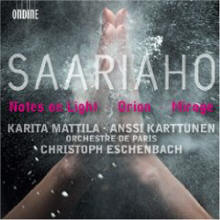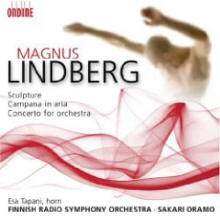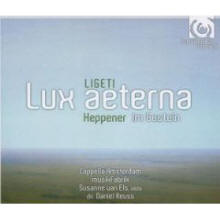|
You are reading the older HTML site Positive Feedback ISSUE 41january/february 2009
Notes of an Amateur -
January 2009, Part 3
Saariaho, Notes on Light, for cello and orchestra; Orion, for orchesta; Mirage, for soprano and orchestra. Karita Mattila, soprano. Anssi Karttunen, cello. Orchestre de Paris, Christopher Eschenbach, conductor. Ondine ODE 11302. Back out onto the frontiers of modernism we go, with Finnish avant-garde composer Kaija Saariaho's latest recordings. There is always something both disorienting and exhilarating in having new music (two of these works are world premiere recordings) from the Saariahos, Lindbergs, Ligetis, and Gubaidulinas of the world. We come to them with few bearings, hoping to glimpse the future but aware that we could also be going down a pointless path to a dead end. That is the nature of true exploration. With Saariaho, we are listening to a composer who in retrospect (which is how history is written!) may come to be seen as the center of the movement to redefine music as the expression of space, light, and stillness rather than of narrative movement and development in time. Not the first to venture down this path by a long shot—its Western roots are in the New Vienna School of the early twentieth century, and it can be heard evolving and developing in Elliot Carter, wandering off into the wilderness with the likes of Mortan Feldman—she is a nominee for composer most likely to bring it to maturity. Some feel her work may eventually bring order to the whole ‘movement' as major artistic creations often do. Part of expressing stillness and timelessness is creating hints of its opposite, something many other composers of her ilk do not understand. She makes this notably clear in Orion, who as a musical character is both Hunter and object of contemplation in the Winter Sky; and also in Mirage, a trance-induced vision of a Shaman and healer. The goal in this kind of music is not to create a likeness of light and transcendence but an expression of it. Her understanding of this fact is what elevates her music above many other attempts. It is what draws us to it rather than sending us off into private reveries. It is ultimately the difference between art and nice (or not so nice) noise. It is instructive that both Saariaho and Gubaidulina cite the poetry of T.S. Eliot. It will be interesting to see if her work can find its way into and affect the mainstream of modern music. It has already won academics and critics, which is generally how these things begin.
Magnus Lindberg, Sculpture for Orchestra; Campana in Aria for horn and orchestra; Concerto for Orchestra. Esa Tapani, horn. Finnish Radio Symphony Orchestra, Sakari Oramo, conductor. Ondine ODE 11242. Lindberg is generally conceded to be the other leading avant-garde Finnish composer of our time. Both major works in this program play like concertos for orchestra. Sculpture (2004) features great orchestral transparency—instrumental textures weaving in and out of one another. The Concerto for Orchestra itself (2003) starts out in the same vein but becomes more interesting and texturally complex. What is this music? Sculpture sounds like a modernist version of Respighi's Fountains of Rome—music that is brilliant, highly descriptive, and which doesn't so much go somewhere as be somewhere. The Concerto for Orchestra ends up sounding more like a stationary version of its namesake by Bartok. Both works aim for an effect that has no narrative flow and direction. Whirling but otherwise essentially stationary high modernism. Again, both works are concerto-like, with flashing solo sections, and both are more sculpture than story. The short horn concerto (compagna in aria means playing with the bell of the horn facing up to achieve more brilliance) is especially bold and brash. Clearly in these works Lindberg's musical goal is to maintain the sound of modernism but, like Saariaho, to present it in a more spatial, less developmental form. It could not sound more different than hers—there is not a meditative moment in it—but structurally their aims are similar. And I apologize for sounding so repetitious here, but sometimes the music makes us so.
Ligeti, Lux Aeterna; Viola Sonatas. Heppener, Im Gestein. Capella Amsterdam, MusikFabrik. Susanne Els, viola. Daniel Reus, director. Harmonia Mundi HM 901985. Dissonant choral music—first heard in modern times by many of us in Legeti's Lux Aeterna, borrowed by Stanley Kubrick for 2001 Space Odyssey, but descended from the close harmonies of medieval and renaissance religious music—is strong stuff. Tender ears need not attend. This album offers Lux Aeterna, Ligeti's disharmonically similar but more mobile Three Fragments after Hölderlin, and Ligeti contemporary Robert Heppener's Im Gestein, a related but moderately more conservative choral piece. These works are surrounded by three solo viola works by Ligeti. The viola pieces are actually parts of a six movement Sonata for Viola assembled over four years by the composer from these and other pieces, though each seems to have a musical life of its own. Moving from the Heppener work to the Phantasies of Ligeti and then on to Lux Aeterna takes us on what amounts to an aesthetic journey from the ionosphere out into space. Kubrick chose well. Our relation to the world moves from the tenuous to the ineffable. This can be enthralling, nearly unbearable, or some of both. For this kind of music to be successful, a composer must persuade us that the worlds he builds are inhabitable, even if only by the imagination. If he fails, the result can be simply annoyingly discordant noise that sends some flying from the room, or hokum. But we must be willing to let him try! There will be some cautious and resistant listeners who will indeed fly from this music. It asks a good deal of us. I find it mainly successful, partly because especially the Heppener work strikes me as several steps beyond where Britten's choral music for children left off. Britten might well say a step or two too many because it cuts ties to the past he was unwilling to cut. Which is the point of much dissonant choral music: that the kind of experience this music seeks to express—namely aspects of the eternal—is fundamentally different from ordinary, even ordinary spiritual experience. We are accustomed to hearing this difference expressed as more beauty. Ligeti and Heppener are saying, along with other modernists composing music of this kind, that it is not more anything: it is simply and profoundly different. The Heppener Im Gestein is followed by a short piece of a capella Gregorian chant, adapted by Heppener. A brilliant touch which sets the entire program into both a spiritual and artistic context by reminding us where this spare aesthetic comes from. So while much of this music does appear to cut ties with the past, it is clearly a past that is recoverable. The three works for solo viola by Ligeti fit well into the overall program, both because of the sonic contrast they provide and the closer tie to the earth the hoarse texture of the viola cannot help but express. If you have any genuine interest in the frontiers of music—and remember there was a time not so long ago when we found even Bartok's String Quartets uninhabitable – I urge you to try this album.
System used for this audition: Audio Note CDT3 transport and Dac 4.1 Balanced Signature, Blue Circle BC3000 II/GZpz preamplifier and BC204 hybrid stereo amplifier, Jean Marie Reynaud Offrande Supreme speakers. With Blue Circle BC6000 line conditioner. Audio Note Pallas, Sootto, and Sogon interconnects and Lexus speaker cable. Bob Neill, in addition to being an occasional equipment and regular music reviewer for Positive- Feedback Online, is also proprietor of Amherst Audio in Amherst, Massachusetts, which sells equipment from Audio Note, Blue Circle, and JM Reynaud, among others.
|



